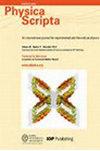Exceptional anisotropic superhydrophobicity of sword-lily striated leaf surface and soft lithographic biomimicking using polystyrene replica
IF 2.6
3区 物理与天体物理
Q2 PHYSICS, MULTIDISCIPLINARY
引用次数: 0
Abstract
Herein, we report unusually high anisotropic superhydrophobicity, unidirectional self-cleaning, and biomimicking of adaxial sword-lily (Gladiolus hortulanus) leaf comprising three distinct levels of surface textures. Observably, the static anisotropic wetting and rolling of water droplets are more favourable in the parallel (or, striation) direction than in the perpendicular direction. Inspired from such water repellency of the sword lily leaf surface, here bio-mimicked polystyrene (PS) leaf construct is developed through a soft lithographic technique. Considering different water droplet sizes (4–10 μl) on natural lily leaf and bio-mimicked PS construct surfaces, the respective parallel (θ||) and perpendicular (θ⊥) water contact angles (WCAs) stand at, θ|| ∼143°–147°, θ⊥ ∼156°–169°; and θ|| ∼130°–139°, θ⊥ ∼142°–145°. Moreover, the specimens under study exhibit roll-off angles ranging, α|| ∼8°–23° (α⊥ ∼16°–41°) and α|| ∼21°–49° (α⊥ ∼40°–55°) along parallel (and perpendicular) directions; respectively. A noticeable difference in α⊥ and α|| values can be ascribed to the profound three-phase contact line (TCL) pinning along the perpendicular direction taking advantage of striation as means of barrier. The roll-off angles can also alter due to a variation in the droplet volume. The unusual anisotropic superhydrophobicity and unidirectional droplet roll-off can be attributed to the entrapped air within the micro-nano texture beneath the water droplet along with the pinning effect in the perpendicular direction caused by the striated heights.剑莲条纹叶表面的特殊各向异性超疏水性以及利用聚苯乙烯复制品进行的软光刻生物仿真
在此,我们报告了由三个不同层次的表面纹理组成的剑莲(Gladiolus hortulanus)叶片异常高的各向异性超疏水性、单向自洁性和生物仿生性。可以观察到,水滴的静态各向异性润湿和滚动在平行(或条纹)方向比垂直方向更有利。受剑百合叶片表面憎水性的启发,我们通过软光刻技术开发了生物仿真聚苯乙烯(PS)叶片结构。考虑到天然百合叶片和生物仿真聚苯乙烯(PS)构建体表面的不同水滴大小(4-10 μl),平行(θ||)和垂直(θ⊥)水接触角(WCA)分别为:θ|| ∼ 143°-147°,θ⊥ ∼ 156°-169°;和 θ|| ∼130°-139°, θ⊥ ∼142°-145°。此外,所研究的试样沿平行(和垂直)方向的滚动角范围分别为 α|| ∼8°-23° (α⊥ ∼16°-41° )和 α|| ∼21°-49° (α⊥ ∼40°-55° )。α⊥和α||值之间的明显差异可归因于沿垂直方向的三相接触线(TCL)利用条纹作为阻挡手段而产生的深刻针销作用。液滴体积的变化也会导致滚降角的改变。不寻常的各向异性超疏水性和单向水滴滚降可归因于水滴下方的微纳米纹理中夹带的空气以及条纹高度在垂直方向上造成的引脚效应。
本文章由计算机程序翻译,如有差异,请以英文原文为准。
求助全文
约1分钟内获得全文
求助全文
来源期刊

Physica Scripta
物理-物理:综合
CiteScore
3.70
自引率
3.40%
发文量
782
审稿时长
4.5 months
期刊介绍:
Physica Scripta is an international journal for original research in any branch of experimental and theoretical physics. Articles will be considered in any of the following topics, and interdisciplinary topics involving physics are also welcomed:
-Atomic, molecular and optical physics-
Plasma physics-
Condensed matter physics-
Mathematical physics-
Astrophysics-
High energy physics-
Nuclear physics-
Nonlinear physics.
The journal aims to increase the visibility and accessibility of research to the wider physical sciences community. Articles on topics of broad interest are encouraged and submissions in more specialist fields should endeavour to include reference to the wider context of their research in the introduction.
 求助内容:
求助内容: 应助结果提醒方式:
应助结果提醒方式:


